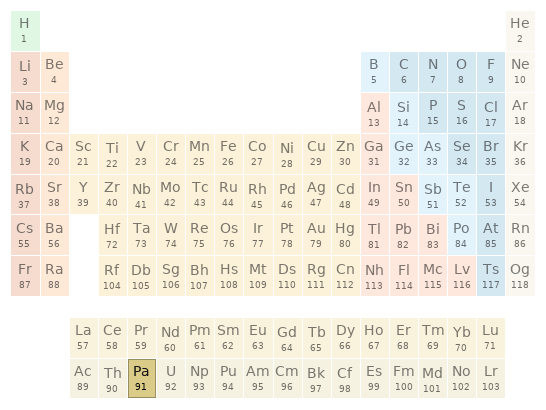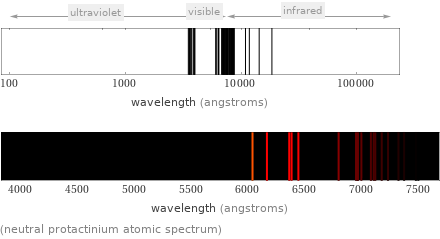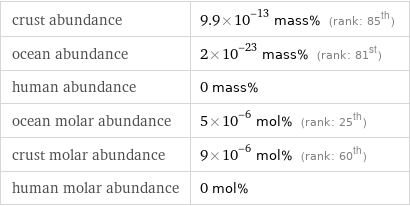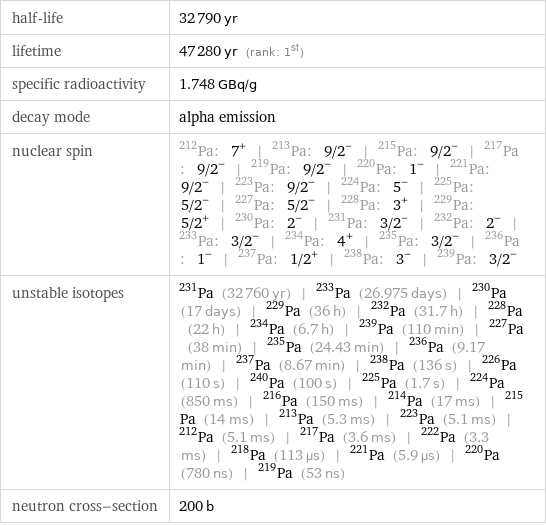Input interpretation

protactinium (chemical element)
Periodic table location

Periodic table location
Image

Image
Basic elemental properties
![atomic symbol | Pa atomic number | 91 short electronic configuration | [Rn]7s^25f^26d^1 Aufbau diagram | 6d 5f 7s block | f period | 7 atomic mass | 231.03588 u (unified atomic mass units) (atomic mass number given for longest-lived isotope) half-life | 32790 years](../image_source/b9c6ccd9d6d78709bbee5479216752ab.png)
atomic symbol | Pa atomic number | 91 short electronic configuration | [Rn]7s^25f^26d^1 Aufbau diagram | 6d 5f 7s block | f period | 7 atomic mass | 231.03588 u (unified atomic mass units) (atomic mass number given for longest-lived isotope) half-life | 32790 years
Thermodynamic properties

phase at STP | solid melting point | 1572 °C (rank: 22nd) boiling point | 4000 °C (rank: 14th) molar heat of fusion | 15 kJ/mol (rank: 33rd) molar heat of vaporization | 470 kJ/mol (rank: 17th) specific heat at STP | 99.1 J/(kg K) (rank: 85th) (properties at standard conditions)
Material properties

density | 15.37 g/cm^3 (rank: 11th) molar volume | 15.032 cm^3/mol thermal conductivity | 47 W/(m K) (rank: 37th) (properties at standard conditions)
Electromagnetic properties

electrical type | conductor resistivity | 1.8×10^-7 Ω m (ohm meters) electrical conductivity | 5.6×10^6 S/m (siemens per meter) magnetic type | paramagnetic volume magnetic susceptibility | 4.995×10^-4 mass magnetic susceptibility | 3.25×10^-8 m^3/kg (cubic meters per kilogram) molar magnetic susceptibility | 7.509×10^-9 m^3/mol (cubic meters per mole) superconducting point | 1.4 K (kelvins) color | (silver)
Reactivity

valence | 5 electronegativity | 1.5 first ionization energy | 568 kJ/mol (kilojoules per mole) ionization energies | 568 kJ/mol
Atomic properties

term symbol | ^4K_(11/2) atomic radius | 180 pm covalent radius | 200 pm (electronic ground state properties)

(neutral protactinium atomic spectrum)
Abundances

crust abundance | 9.9×10^-13 mass% (rank: 85th) ocean abundance | 2×10^-23 mass% (rank: 81st) human abundance | 0 mass% ocean molar abundance | 5×10^-6 mol% (rank: 25th) crust molar abundance | 9×10^-6 mol% (rank: 60th) human molar abundance | 0 mol%
Nuclear properties

half-life | 32790 yr lifetime | 47280 yr (rank: 1st) specific radioactivity | 1.748 GBq/g decay mode | alpha emission nuclear spin | Pa-212: 7^+ | Pa-213: 9/2^- | Pa-215: 9/2^- | Pa-217: 9/2^- | Pa-219: 9/2^- | Pa-220: 1^- | Pa-221: 9/2^- | Pa-223: 9/2^- | Pa-224: 5^- | Pa-225: 5/2^- | Pa-227: 5/2^- | Pa-228: 3^+ | Pa-229: 5/2^+ | Pa-230: 2^- | Pa-231: 3/2^- | Pa-232: 2^- | Pa-233: 3/2^- | Pa-234: 4^+ | Pa-235: 3/2^- | Pa-236: 1^- | Pa-237: 1/2^+ | Pa-238: 3^- | Pa-239: 3/2^- unstable isotopes | Pa-231 (32760 yr) | Pa-233 (26.975 days) | Pa-230 (17 days) | Pa-229 (36 h) | Pa-232 (31.7 h) | Pa-228 (22 h) | Pa-234 (6.7 h) | Pa-239 (110 min) | Pa-227 (38 min) | Pa-235 (24.43 min) | Pa-236 (9.17 min) | Pa-237 (8.67 min) | Pa-238 (136 s) | Pa-226 (110 s) | Pa-240 (100 s) | Pa-225 (1.7 s) | Pa-224 (850 ms) | Pa-216 (150 ms) | Pa-214 (17 ms) | Pa-215 (14 ms) | Pa-213 (5.3 ms) | Pa-223 (5.1 ms) | Pa-212 (5.1 ms) | Pa-217 (3.6 ms) | Pa-222 (3.3 ms) | Pa-218 (113 µs) | Pa-221 (5.9 µs) | Pa-220 (780 ns) | Pa-219 (53 ns) neutron cross-section | 200 b
Identifiers

CAS number | 7440-13-3